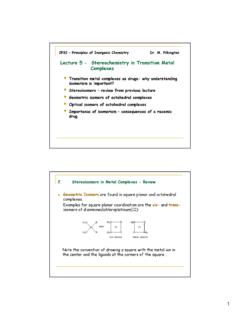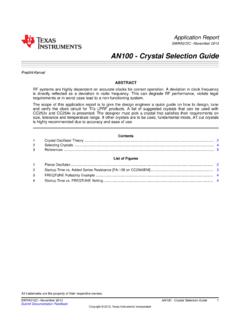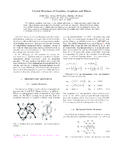Transcription of Lecture 7 Crystal Field Theory for Octahedral …
1 12P32 Principles in Inorganic ChemistryDr. M. Pilkington What should a bonding Theory explain color, magnetism, coordination number and reactivity. Electrons in d-Orbitals, shapes of d-Orbitals Splitting of the d-Orbitals in an Octahedral Field Consequences of d-Orbital Splitting: Magnetism Consequences of d-Orbital Splitting: ColorLecture 7- Crystal Field Theory for Octahedral ComplexesBoats and propellers:If you have a single engine, inboard installation, the stern will pull to port (left) when you go into reverse, if you have a right handed propeller. A left-handed propeller will pull the stern to starboard (right) when in reverse. (Note: You can tell whether your propeller is right (delta) or left-handed (lambda) by the way your boat handles in reverse.) So a propeller is chiral but left and right handed propellers just push the water in different Electron Configuration of Transition-Metal Ions The relationship between the electron configurations of transition-metal elements and their ions is complex.
2 Example:Let's consider the chemistry of cobalt which forms complexes that contain either Co2+or Co3+ions. The electron configuration of a neutral cobalt atom is written as : [Ar] 4s23d7 The discussion of the relative energies of the atomic orbitals suggests that the 4sorbital has a lower energy than the 3dorbitals. Thus, we might expect cobalt to lose electrons from the higher energy 3dorbitals, but this is notwhat is observed. The Co2+and Co3+ions have the following electron +: [Ar] 3d7Co3+: [Ar] 3d6 In general, electrons are removed from the valence-shell sorbitals before they are removed from valence dorbitalswhen transition metals are fast way of working out the d-electronic configuration of a TM ion is to subract the oxidation number of the ion away from its group What Should a Bonding Theory Explain? of Transition Metal Complexes Why are most transition metal complexes brightly colored, but some aren't?
3 Why do the colors change as the ligand changes? As a typical example, consider three complexes of the nickel(II) ion: [Ni(CN)4]2-yellow[Ni(NH3)6]2+deep blue[Ni(H2O)6]2+green Why do the colors change as the oxidation state of the metal changes, even for complexes of the same ligand? Here are some examples of this phenomenon: [Cr(H2O)6]2+[Cr(H2O)6] 3+violetpale blue[Co(NH3)6] 2+[Co(NH3)6]3+redyellow-brown[NiF6]3-[Ni F6]2-violetredH2O and NH3are both colorless, but when they form a coordinate compound they change The Magnetic Moment of a Complex and the Number of Unpaired ElectronsBefore we can pose our questions, we need to know:(i) how the number of unpaired electrons can be determined, and (ii) how it is related to the magnetic moment of a Gouy balancecan used to measure the mass of a sample first in the absence of a magnetic Field , and then when the magnetic Field is switched on.
4 The difference in mass can be used to calculate the magnetic susceptibilityof the sample, and from the magnetic susceptibility the magnetic momentcan be obtained. The magnetic susceptibilityand thus the magnetic momentare due to moving charges. In an atom, the moving charge is an electron: The Gouy balance The Gouy method makes use of the interaction between unpaired electrons and a magnetic Field ; a diamagnetic material is repelled by a magnetic Field , whereas a paramagnetic material is attracted into it. The compound for study is placed in a glass tube, suspended from a balance on which the weight of the sample is recorded. The tube is placed so that one end of the sample lies at the point of maximum magnetic flux in an electromagnetic Field while the other end is at a point of low flux. Initially the magnet is switched off, but on applying a magnetic Field , paramagnetic compounds are drawn into it by an amount that depends on their number of unpaired electrons.
5 The change in weight caused by the movement of the sample into the Field is recorded, and from the associated force it is possible to calculate the magnetic susceptibility of the compound. The effective magnetic moment can then be derived. Nowadays for research, we use a SQUID(superconducting quantum interference device) for measuring magnetic susceptibilities. It is extremely the 3d transition metals, the orbital moment is not very important , and the measured magnetic moment can be directly related to the number of unpaired electrons in the ion. This value is called the spin-only magnetic moment, and its units are Bohr Magnetons ( ). magnetic moment, of unpaired electrons Why do different complexes of the same metal ion in the same oxidation state have different numbers of unpaired electrons? Some examples follow for Fe3+, Co3+, and Ni2+: K2[Ni(CN)4] = 0; no unpaired electrons[Ni(NH3)6]Cl2 = ; 2 unpaired electrons[Co(NH3)6]Cl3 = 0; no unpaired electronsK3[CoF6] = ; 4 unpaired electronsK3[Fe(CN)6] = ; 1 unpaired = ; 5 unpaired electrons Why are there only certain values of the number of unpaired electrons for a given metal ion?
6 For example, complexes of Fe(II) and Co(III) can only have zero or 4 unpaired electrons, never two. Complexes of Fe(III) can only have 5 unpaired electrons or 1 unpaired electron. Why is it that for Ni2+complexes, all Octahedral complexes have 2 unpaired electrons (paramagnetic), but square planar complexes are diamagnetic (no unpaired electrons)? Co [Ar] 3d74s2Co3+ [Ar] 3d64 unshared pairs of electrons5iii. Coordination Numbers and Geometries Why do some transition metal ions seem to have a fixed coordination number and geometry, but other metal ions are quite variable? Examples:Pt4+always octahedralPt2+practically always square planarNi4+only Octahedral complexes knownNi2+ Octahedral and square planar complexes common; some tetrahedral complexes knownCo2+6-coordinate Octahedral and 4-coordinate tetrahedral complexes knownCo3+practically always 6-coordinate, octahedralCr3+practically always 6-coordinate, octahedraliv.
7 Reactivity Why do some metal complexes undergo ligand-exchange reactions very rapidly and other similar complexes react very slowly, even when reaction is thermodynamically favorable? As an example, consider the reaction between hexaamminecobalt(III) ion and hydronium ion: [Co(NH3)6]3++ 6H3O+---> [Co(H2O)6]3++ 6NH4+The equilibrium constant for this reaction is approximately 1x1025, and yet an acidic solution of the hexamminecobalt(III) ion requires several days before noticeable change occurs. In contrast however, the corresponding copper(II) complex:[Cu(NH3)6]2++ 6H3O+ ---> [Cu(H2O)6]2++ 6NH4+In this case, acidification of the hexamminecopper(II) complex results in practically instantaneous reaction. We will find the answers to these questions as we study the simplest bonding Theory for transition metal complexes, called Crystal Field Electrons in d-Orbitals All d-orbitals have the same energy(in spite of their different shapes and/or orientations) on a bare metal ion.
8 However, some d-orbitalshave different energiesfrom the others in a metal complex. This is called d-orbital splitting. Consider the 5 d-orbitals in an xyz coordinate system. We will not try to give perspective drawings, rather we will rotate the coordinate system so that it is easy to draw the black and white lobes refer to the alternating sign of thewavefunctionyxdxyYou will need to be able to draw the d-Orbitals for the five d-Orbitals73. Splitting of the d-Orbitals in an Octahedral FieldMLLLLLLML6 MLMML6 OctThe odd-shaped dz2orbital results because there are six solutions to the Schroedinger equationfor the angular momentum quantum number l (the d-orbitals), but only 5 solutions are independent. The combination of two orbitals produces the unique dz2orbital: Coulomb s Law Energy of interaction between two charges q1q2is proportional to the product of charges divided by the distance between there centres.
9 Rq1q2E is proportional to q1q2/rCrystal Field Theory - Assumptions Focuses on the d-orbitals of the metal. Assumes ionic bonding between the metal and the ligand instead of covalent bonding ionic bonding due to electrostatic interactions Electrostatic interactions in a complex between +ve metal ion and vecharges of ligand - treats ligands as point (negative) charges. If the ligand is negatively charged: ion-ion interaction. If the ligand is neutral : ion-dipole interaction. Provides stability and holds complex together. Repulsion between the lone pair of electrons on the ligand and the electrons in the d-orbital of the metal ion This influences the d-orbital energies8 Lets look in more detail to see what happens to the energies of electrons in the d-orbitals as six ligands approach the bare metal ion: If we compare the dxyand the dx2-y2, we can see that there is a significant difference in the repulsion energy as ligand lone pairs approach d-orbitals containing electrons.
10 Electrons in the dxyorbital are concentrated in the space between the incoming in the dx2-y2orbital point straight at the incoming Now, dxzand dyzbehave the same as dxyin an Octahedral Field , and dz2behaves the same asdx2-y2. This means that the d-orbitalsdivide into two groups, one lower energy than the other, as shown in the following diagram. The dxy, dxz, and dyzorbitals are collectively called the t2gorbitals, whereas the dz2 and dx2-y2 orbitals are called the egorbitals. The Octahedral splitting energy is the energy difference between the t2gand egorbitals. In an Octahedral Field , the t2gorbitals are stabilized by 2/5 o, and the egorbitals are destabilized by 3/5 o. 4. Consequences of d-Orbital Splitting: Magnetism Let's consider the complexes [Fe(H2O)6]Cl3(mu = ; 5 unpaired electrons) and K3[Fe(CN)6] ( = ; 1 unpaired electron). The free Fe3+ion is a d5ion.










